Archive for November 30, 2009
“The terrors of God do set themselves in array against me.”
November 30, 2009Past kindness or consideration. Past justice. Past satisfaction. Past warmth or cold or comfort. Past love. But past surprise? What an endlessly unfolding tedium life would then become. No, Doris, we must not let you be past surprise.
–Francis Wolcott, Deadwood
With all due respect to Mr. Wolcott’s hard-earned wisdom on the topic of a life past surprise, A Serious Man suggests that the flipside of that coin isn’t such great shakes either: A life of constant surprise is indistinguishable from an endlessly unfolding nightmare. As a matter of fact Larry Gopnik, the lead character–whether he’s the titular character is up for debate–has a few actual nightmares, and for varying lengths of time before their resolution you can’t even tell that that’s what they are.
The suburban ’60s Minneapolis the Coen Brothers construct here is an inferno of monstrous self-absorption, obliviousness, and unreasonableness, but rigorously curated so not a whiff of outright parody or condescension can be detected. There’s no out to be found there–these cluttered offices, treeless streets, and hazy screen doors, these nasty neighbors, shrill children, hateful loved ones, and pompous clergymen are crushingly familiar, even if we’re simply seeing their worst excised from the rest of their existence and paraded before us as they buffet Larry to the brink.
Moreover, their world is utterly in thrall to authority, but those authority figures are no recourse. They’re inscrutable, often incommunicado, as likely to blow you off or keel over and die on you as to offer you a glimmer of hope. It’s a world where, as Larry’s dream self points out, he makes a living teaching students that while they can never hope to really know anything, they’ll be responsible for it on tests. It’s a world where a St. Olaf-ian bubbe meise told by a rabbi who can barely be bothered to deliver the punchline is soundtracked by Jimi Hendrix’s single most direct response to the senseless slaughter of Vietnam. So thoroughly lapsed a Catholic am I that I didn’t pick up on the parallels of Larry’s plight with that of Job until deep into the film, but Larry has it worse: Job, at least, could talk to God Himself, but Larry gets saddled with the junior rabbi.
Speaking of rabbis–and we ought to; all three get Tarantino-style title cards, for crying out loud–this is the Coens’ “Jewish movie,” even moreso than Barton Fink. In part this just gives them some rich adolescent nightmare fuel to feed upon, from Hebrew school to bar mitzvahs. (Even a goy like me nearly experienced PTSD during that scene.) But it also enables them to show ethnicity and religion as utterly oppressive. And I mean that in the sense of weight: These characters and images seem to creak and groan beneath the weight of the accumulated centuries of culture–both the internal culture of tradition and the external culture of hatred and stereoytping–that gave them birth, stirring something close to terror at unfathomable roots. This to me is the source of the horror in the film’s opening sequence–not just the visitor’s potentially supernatural origin, but his age, the sense that behind his snowy beard and dry cackle lie the accumulated ages, for good or ill. I know that “self-hatred” is a particularly loaded and even loathsome term with very specific sociopolitical baggage among Jews, so I want to be clear that’s not what I mean–I mean the sense you can get that when it comes to certain individuals of your acquaintance, most particularly yourself and the people you care about, the ancient and fabled foibles of your people are realer than you’d care to admit. I’m Irish, I’ve felt it. Yes, the film’s single most well-meaning and charitably depicted character, the woman with whom Larry shares a seemingly heartfelt heart-to-heart at the beach, seems to have taken genuine comfort in her faith–but the same God who comforts her crippled her.
With that in mind it’s worth pointing out that the film tells two parallel stories itself–those of Larry and his stoner son Danny. At first, clever editing leads us to believe they’re the same story, one a flashback for the other. And though for a long time Danny seems like his father in miniature, unlike him in that he’s unserious to a fault but like him in that life has him in just over his head, his story appears to be headed for a happy ending. He pulls off his transition to manhood while apocalyptically baked (thanks in part to a glance at the sultry Mrs. Samsky, a rare ray of sunshine for Larry as well (and, thanks to a lifelong case of whatever the reverse of shiksappeal is, for me too)), and he receives a life-saving gift and words of true wisdom across a chasm of generations from the head rabbi in charge. But while the closing image of his story is more open-ended than that of Larry’s, it’s still frightening–awesome, in the original sense. Just when he’s about to say what he needs to say to set everything right, something aw(e)ful knocks the words right out of his mouth. And as we’ve learned from Larry, God will never answer out of the whirlwind. Surprise.
Carnival of souls
November 30, 2009* Dan DiDio vs. Joe Quesada on “event fatigue.” This kind of thing is endlessly interesting to me.
* Tom Spurgeon reviews Al Columbia’s Pim and Francie: “this book outright indicts the act of creativity itself.” Shiver.
* Speaking of Spurge, make sure to check out his annual Black Friday Holiday Shopper’s Guide, a tradition I look forward to nearly as much as his San Diego guide. There’s a soul-crushing profusion of good comics to buy.
* Also speaking of Spurge, I appreciated this:
His primary argument as I understood it wasn’t that rankings always work and are always awesome and time well spent, but that he felt the AV Club’s failure to order their list was another choice among many that contributed to their list lacking specificity and weight.
Yep!
* Oh fuck Fantagraphics is a great publisher. More Jaime Hernandez digests! Nancy! Artichoke Tales! Wally Gropius! I could plotz.
* A thousand times yes to this amazing Spanish promo for Lost: Come for the deftly done chess visuals, stay for the deftly selected Radiohead soundtrack.
* A thousand times also yes to Dahmer and The Hurt Locker star Jeremy Renner as Hawkeye, should this pan out.
* A thousand times also also yes to Hellen Jo drawing Lady Gaga and a bunch of other sessy ladies for Giant Robot’s Post-It Show. (Via Heidi Mac.)
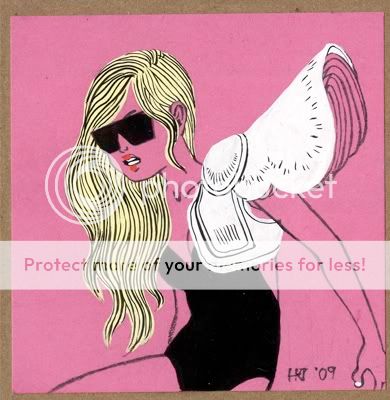
* Paranormal Activity director Oren Peli realizes if it ain’t broke, don’t fix it: His already-finished next film, Area 51, is another found-footage first-person shockumentary thing. The Blair Witch guys probably shoulda stuck with it too.
* Curt Purcell quite liked the latest round of the main Blackest Night books. So did I.
* Real-Life Horror: The Supreme Court sides with the cover-up of detainee-abuse photos.
* Finally, Big Lob, thou art avenged!

Comics Time: High Moon Vol. 1
November 30, 2009
High Moon Vol. 1
David Gallaher, writer
Steve Ellis, artist
DC/Zuda, 2009
192 pages
$14.99
Read the strip at ZudaComics.com
Evolution in action? Here’s a case of the constraints of a comic’s production saddling it with weaknesses, only for the comic to come up with compensatory values that all but overcome them. High Moon is a Western-horror hybrid of the sort very much in vogue over the past few years–what hath Ravenous wrought?–which originally ran in DC Comics’ webcomics portal/competition site Zuda. I believe this necessitated a Sunday-strip-style landscape-format rectangular page, longer than it is tall, as well as a daily-installment delivery mechanism. The storytelling suffers for it all. There’s pretty much one plot beat per panel, with very little breathing room, and moreover nearly every panel contains terse pulp dialogue; the resulting rhythm is staccato to the point of incomprehensibility at times. It doesn’t help that writer David Gallaher’s characters are almost all types, making it even tougher to tell the players at times.
But! Sweet Jesus, look at Steve Ellis’s art. His color palette is a real revelation, fiery oranges and glacial blues all but radiating off the page even despite the book’s rough paper stock. The faces of his hardass outlaws and their lovely ladyfriends come off like a cross between fellow horror artists Terry Moore and Guy Davis, their broad-strokes emotions and intentions easy to parse amid the occasional confusion. I was particularly impressed with his creature designs, admirably ambitious and taking full advantage of Gallaher’s unique, expectation-defying brand of horror-on-the-range. I think I even detected a Robert Williams homage! Ellis’s unnecessarily lovely brushwork really shines in splashpage-style illustrative moments, where you can just sit and stare at the flowing hair and shattered glass and monstrous limbs without feeling propelled to the next rapid-fire panel. It enhances the strengths of Gallaher’s scripting–which include at least one dramatic shift in the story’s direction and an entertaining willingness to throw everything from steampunk to The Crow into the mix–and smooths over some of the weaknesses. Provided you don’t mind when action-horror tilts way way over toward the action end of things, this book is well worth checking out.
Comics Time: Chester 5000 XYV
November 27, 2009
Chester 5000 XYV
Jess Fink, writer/artist
ongoing webcomic, August 2008-November 2009 (and counting)
A steampunk porn webcomic: By god, is this the most Internet-y thing the Internet has ever produced? Regardless, it’s certainly an advertisement for the potential of the web as a publishing mechanism for comics. You can do page after page after page of a cheerful, even sentimental comic drawn in a friendly, loose-fit Craig Thompson-y style (lots of dot-eyes and pointy noses and rapturous swirls) about a woman getting fucked by a robot with a mustache, and Diamond minimums be damned. I stumbled across this by following a link trail from Kate Beaton’s place, which seems somehow appropriate–good luck getting your gag-comic series about historical figures off the ground without a David Finch variant cover, too.
To set the scene: It’s the story of a workaholic Victorian-era scientist who, unable to satisfy his lovely wife’s needs when he’s knee-deep in lab work, builds her, essentially, the world’s most sophisticated vibrator: A humanoid robot who can go-go-go-go and keep the missus busy when the Scientist’s working. Unfortunately for him but fortunately (?) for them, the lady and the robot (the titular Chester) fall in love, as best I can tell because the sex is really awesome and because of Chester’s “programming”–the scientist placed a picture of his wife where the robot’s heart would go. Eventually the Scientist attempts to sell Chester off to a local widow, but Chester has ideas of his own, and this other lovely young lady gets embroiled in the shenanigans, where we’re currently left as of the strip’s latest installment.
My relationship with this comic as I read its year-plus run in one go fluctuated fairly wildly, which surprised me. Now, steampunk’s not really my thing, and the very twee line and look Fink employs generally needs to be shored up by some genuinely meaty content to pass muster with me. Of course, this being a porno comic, there’s a pretty simple way to figure out if it’s working, and work it does. It’s graphic, so there’s that, and there’s a repeated emphasis on clitoral stimulation that all but single-handedly (rimshot!) makes up for the American education system’s sex-ed dropped ball on that score, which has left generations of young men unable to find the thing with a map and a flashlight. (Please change your standards in this regard, Department of Education–the high school girls of America will thank you!) But in addition to all the sensually drawn close-ups of genitalia, Fink has a knack for capturing not just the act, but the desire to act, if you follow me–a look in the lady’s eye as she gets ready to get it on with Chester, the heat-of-the-moment kissing and grabbing and gasping and so on. The build-up to the sequence involving the two women is particularly strong in this regard, though of course I’m a dude with a typical dude’s sensitivities in that area, so, you know, unreliable narrator.
But amid all the cute romance and hot sex and meme-able robot stuff, like I said, there’s some surprisingly tricky terrain. Is the scientist’s obsession with his work really a valid excuse for his wife to so enthusiastically and totally cuckold him–with a gift he gave her, no less? I was pretty sympathetic to the Scientist’s outrage over this–until he took it way too far and flipped my sympathies yet again. When the Widow enters the picture, as much as I enjoyed watching her dive in, I found the notion that, basically, everyone is sexually compatible with everyone…snobbish, in a way? Does that even make sense? But as the four characters are currently coupled off, I feel like we’re seeing adults make a decision about how they really want to live their lives, even though they’re making it with their sex organs at the moment rather then their brains. I don’t know…it’s heady stuff, in its way, and demanding of one’s attention and non-lizard-brain thinking, keeping you actively engaged rather than passively taking in the pretty curved lines and button-pushing romance and dirty drawings. Very interesting.
Comics Time: Just a Man #1, Lost Kisses #9-10, Worms #4, and XO #5
November 25, 2009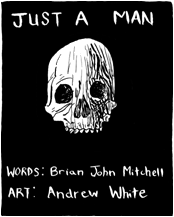
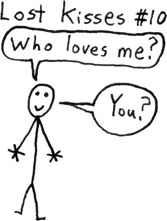 Just a Man #1, Lost Kisses #9-10, Worms #4, and XO #5
Just a Man #1, Lost Kisses #9-10, Worms #4, and XO #5
Brian John Mitchell, writer
Just a Man #1 – Andrew White, artist / 56 pages
Lost Kisses #9 & 10 – Brian John Mitchell, artist / 36 pages each
Worms #4 – Kimberlee Traub, artist / 40 pages
XO #5 – Melissa Spence Gardner, artist / 44 pages
Silber Media, 2009 (I think)
$1 each
Wow, these little suckers put the “mini” in “minicomic.” They’re just under an inch and a half square, limiting the comics they contain to one image-caption pairing per page. It’s an interesting constraint to work impose upon oneself, given that auteur Brian John Mitchell is already up against his own inability to draw. That’s not a subjective assessment, by the way–we’re not talking Jeffrey Brown lo-fi or Brian Chippendale noise or John Porcellino minimalism or Anders Nilsen stick figures or anything else that’s a matter of taste in the Mitchell-drawn Lost Kisses, we’re talking actual stick figures, with little happy-face faces and five even tinier sticks for fingers. Mitchell’s enthusiasm for making comics outstripped his ability to master even its most basic necessities. Which is kinda cute, I’ll admit, and works well enough for the kind of ramshackle navel-gazing confessional humor he’s doing in that particular series, but the air of self-indulgence is unmistakable. Making matters worse is a problem with image flow–I know, hard to believe given that you’re just dealing with one tiny picture and caption on every page. But Mitchell places the drawings on top of the captions even though the drawings respond to what’s said in the captions, so that you either have to read bottom-to-top or constantly spoil the gag for yourself. I have no idea why he does that way–surely he noticed it doesn’t scan? I don’t think it’s a formal innovation done for effect, like Chippendale’s chutes-and-ladders layouts–I just think it’s a mistake.
Which is what makes the other three comics in the envelope Mitchell sent me all the more surprising. Not due to the presence of other artists, mind you–White’s work on Just a Man is scratchily effective, particularly with some effects involving sun glare and flames, but Traub aims for abstraction and ends up coming out just sorta sloppy, while Gardner’s basic cartoony figures look like they came from any number of entry-level webcomics or student-newspaper strips. No, what’s impressive here is how the physical constraints of Mitchell’s tiny format are made to enhance his storytelling. When you have so little room that simply printing a sentence at a legible size eats up half your page, you’ve gotta keep things terse, so why not go hard-boiled and tale tales of murder and mayhem committed by flat-affect protagonists? Just a Man is a Western morality play of violent retribution; a couple of moments overstate the case, I think, but in general it’s a chilling thing, with some memorable facial expressions from White and a surprisingly, refreshingly open and un-cliche ending. XO is a series, but this is apparently the origin story for its blase hitman protagonist, and believe me you didn’t need to know this to appreciate the bracing matter-of-factness with which the character unwittingly but unhesitatingly graduates from selling drugs to eliminating an exceedingly minor threat to that undertaking. Worms is the least effective of the trio–the art just doesn’t do what it wants to do–but the story seems like an engaging enough Cold Heat-style weird-tale sci-fi mindfuck involving a young woman in peril and fighting to break free, and it sure does take a turn for the suddenly brutal at one point. In more assured hands, all three could be really killer melds of form and function. As it stands, they’re maybe not quite there, but if you wanted to spend a measly buck per book, even just to examine what they do right and what they do wrong, you’d have my blessing.
Happy Thanksgiving from your friends at Marvel Super Heroes: What The–?!
November 25, 2009I only wish the title “99 Hulk Balloons” had been my idea.
Hey, look, Christopher Allen interviewed me about comics criticism
November 25, 2009Right here. Chris really pressed me on a lot of my assertions and assumptions, so I had a great time with the interview. I hope you will too!
Carnival of souls
November 24, 2009* I’m pretty happy with the way my Robot 6 piece on what’s wrong with the AV Club’s Best Comics of the ’00s list came out. Please give it a look.
* Elsewhere on Robot 6 I shouted, shouted, shouted out loud Tom Neely’s post-it portraits of metal musicians in corpse paint.

* Curt Purcell dashes himself against the rocks of event-comic tie-ins.
* It’s C.F.’s world, says Blaise Larmee, and we just live in it.
* RIP Ken Krueger, co-founder of the San Diego Comic-Con. These men gave us something wonderful.
Carnival of souls
November 24, 2009* Today on Robot 6: I plugged AdHouse’s big sale, recapped Tom Brevoort’s Marvel vs. DC smacktalk, and recounted The Twilight Saga: New Moon‘s box-office battle with Batman and Spider-Man.
* Eve Tushnet:
This isn’t art you experience, or even art you endure; it’s art you solve.
Boo, hiss!
* Dig this Lane Milburn/Jon Vermilyea Cold Heat print!

* Dig Nick Bertozzi’s rad rejected Stuffed! cover!
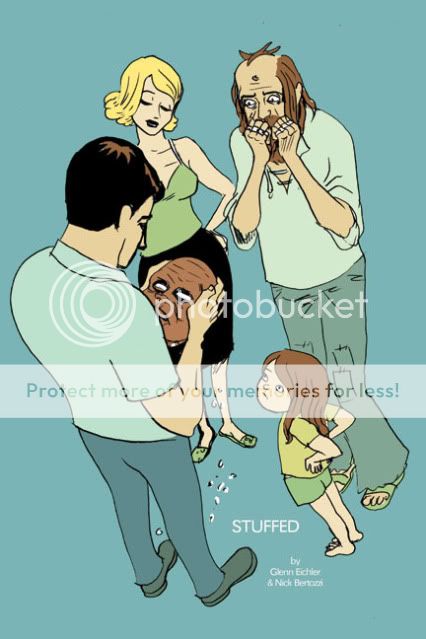
* Dig Matt Rota’s awesome comics!

* Dig Lamar Abrams’ strangely erotic drawings of Joyce DeWitt and a woman in a striped dress farting!
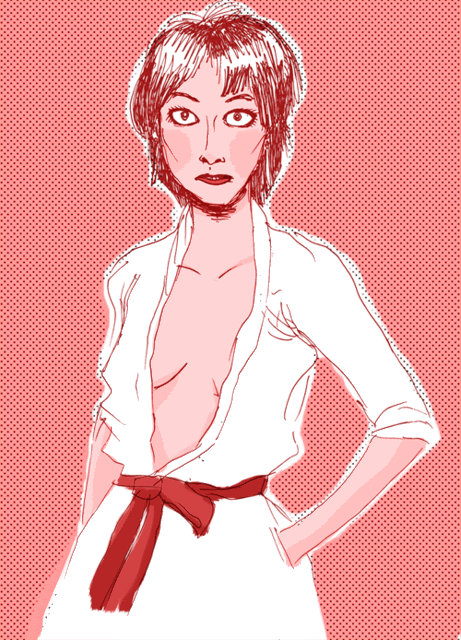
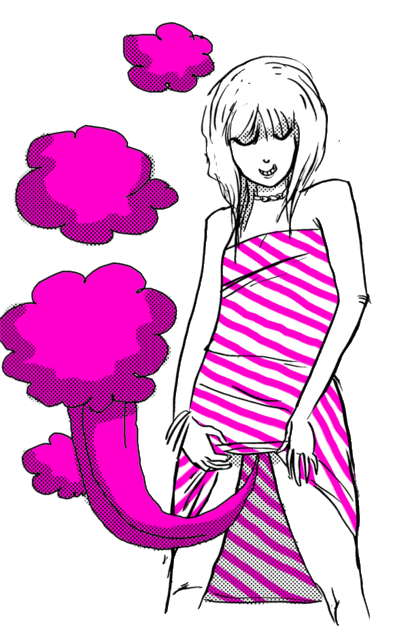
* Tom Spurgeon is collecting nominees for the decade’s best superhero comics, and here’s what people are suggesting.
Comics Time: Remake
November 23, 2009
Remake
Lamar Abrams, writer/artist
AdHouse, May 2009
144 pages
$12.95
Buy it from AdHouse for the low low price of $5.95
Look at that cover! Oh man, striking, isn’t it? As a package–with its bold cover image and tight title font and friendly digest size and Powr Mastrs-style bendy cover and Helvetica-heavy title pages–Remake is somethin’ special. As a comic? Mmmm, I’m not quite there with it. What you’ve got here is a gentle superhero parody in the vein of Jeffrey Brown’s Bighead books–or maybe Bighead crossed with Be a Man, since author Lamar Abrams’s target here seems to be the superhero’s propensity for narcissism, destructiveness, and pique. His “hero,” the diminutive boy-robot Max Guy (he’s not named Remake, much to my surprise; hey, why is this book called Remake anyway?) is a blustery, shallow, self-absorbed asshole. He’s prone to sulking, bragging, talking shit, salting game, pigging out, playing video games, befriending his enemies and alienating his allies, breaking the fourth wall, vomiting, and so on. It sounds fun, if that’s the sort of thing you go for. And Abrams’s art helps, though I prefer the uniform line weight, rigid grid, and simplistic designs of the earlier comics collected here to the looser, more Scott Pilgrim-y work toward the back of the book; the earlier material feels like an experiment in staging dramatic, dynamic action and poses while deliberately underselling them with the tools at your disposal, like an 8-bit cover of “Bohemian Rhapsody.” But here’s the thing: It sounds like more fun than it is. Maybe I just got off on the wrong foot with the book, since its first three strips center on homophobia and animal cruelty gags (I know it’s the character, not the author, but still), but I just didn’t laugh a lot at this. There was a funny bit toward the end where Max Guy comes rocketing down from the stratosphere in the middle of a fight to smack his opponent with a pie to the face, and when he’s asked where the pie came from he said that he bought it from a guy selling them on a cloud, and then there’s a jump cut to a little guy with a mustache on a cloud with a stack of pies who says “I’m practically giving them away!”–that made me laugh. The rest, a borderline meh. It’s energetic cartooning, no doubt, and generally importing video-game influences to create something more free-form than conventional action-adventure comics plotting would allow is a good look, but for me it just didn’t cohere into a whole as winning as some of its parts.
You’re gonna wake up one morning and KNOW which side of the franchise you’ve been shipping on!
November 23, 2009New Moon isn’t really a better movie than Twilight, but it’s a lot more fun. I’ll grant you that seeing it on opening night contributed a great deal to that impression, I’m sure. Now, I’m a neutral party in the big Team Edward/Team Jacob dust-up; I wore a Twin Peaks t-shirt to the screening, so I guess I’m on Team Bob. Still, many of my favorite moments of the evening didn’t take place on screen. There was the shaggy-haired kid with the Judas Priest t-shirt we sat next to, clearly dragged along by his female friends–when we asked if he minded us sitting between him and them, he said “Oh, it doesn’t matter, I’ll probably be asleep through the whole thing anyway”; later he responded to a parodic film-within-the-film action flick by shouting “I wanna be watching that movie!” There was the high-pitched squealing any time a male teenage character (or Ashley Greene’s Alice, for some reason…?) came on screen, doubled in decibels anytime one of them took his shirt off. In that respect it was really 17-year-old Taylor Lautner’s show–when his buff, bare-chested teen-wolf character Jacob spent a scene glowering topless in the rain, there wasn’t a dry seat in the house. And there was the Twi-mom we overheard in the parking lot loudly proclaiming of Lautner (to the chagrin of her daughter), “Six-pack? More like an eight-pack! Believe me–I was counting!”
But even if our screening’s highlights came from the audience and not the film itself, that’s not to say that the film wasn’t a hoot at times too. Sure, I may have gotten more out of scarfing down pretzel bites and nacho cheese and giggling at every collective screech and sigh from our tweenage theater-mates. But don’t let’s forget that before he presided over the stillbirth of the would-be His Dark Materials franchise with The Golden Compass and subsequently shattered box-office records and Batman-fan hearts with New Moon‘s performance this past weekend, Chris Weitz helped helm American Pie. I for one thought he brought that same eye for the absurdity of teenage emotions’ intensity to this material. Ridiculous tableaux abounded here, from the perpetually shirtless posse of Native American were-twinks to a ride in an elevator with our heroes and a trio of vampire-royalty enforcers that nearly brought down the house. And as in the first film, the four human friends of Kristen Stewart’s lead moper Bella were clearly the movie’s most valuable players, from Anna Kendrick’s motormouth remonstrations as Jessica to Michael Welch’s superbly played hormonal awkwardness as Mike.
Best of all, though, were the Volturi, the Italy-based ruling council for the vampires of the Twilight world. Their apparent top dog, Aro, was played by Michael Sheen with all the gleeful giggling gusto of someone who thought it might be fun to pretend he was in a better vampire movie. He’s a grinning, fey freak straight out of the Emperor Paplatine playbook, an undead dandy, and I enjoyed every second he was on screen. Equally impressive in smaller roles–due in large part to their striking appearances–were Daniel Cudmore as Felix, a towering vampire guard who smashes Robert Pattinson’s emo vampire Edward through a roomful of marble furnishings in Zack Snyder slow/fast-motion style; and Dakota Fanning as Jane, a sadistic vampire teen telekinetic upon whom I’d have developed a crippling crush as a kid. The group is responsible for the film’s one true moment of horror, too, albeit offscreen: As Bella, Edward, and Alice are led from their forced audience with Volturi, a tourist group–complete with prominently shot children!–is led in, and their screams as they figure out what’s going on actually are tough to hear.
The Volturi certainly compare favorably to the misbegotten trio of vampiric antagonists whose boilerplate antics gave the first film its nominal climax, a role augmented since author Stephenie Meyer apparently never really bothered to put one in the book, from what I’m told. Edi Gathegi’s dreadlocked and accented Laurent returns here, pulling an unexplained 180 from his face turn in the first film–something Bella actually remarks upon as he prepares to kill her, but with no explanation forthcoming. He gets eaten by werewolves, which is pretty funny. Faring somewhat better is Rachelle Lefevre’s extravagantly red-headed Victoria, out for vengeance for the slaying of her grungy mate James (Cam Gigandet) by Edward and his family in the first movie. I don’t think she says a single word in this movie–and behind-the-scenes shenanigans have led her to be replaced by Bryce Dallas Howard in subsequent sequels, so oh well–but she makes a hell of an impression in two of the film’s most visually impressive sequences. First, she has a long chase sequence with the wolfpack, choreographed Matrix-style and soundtracked beautifully by Thom Yorke (!). Second, even though this breaks even more vampire rules than the astonishingly dopey “sparkle in the sunlight” thing, she ends up in the ocean at one point, and the two brief shots we get of her in there point to a visually rich vein of “water vampire” fiction should anyone else feel comfortable throwing tradition to the wind.
All that being said, New Moon is still, in many respects, a train wreck. For one thing it’s riddled with plot holes big enough to drive Bella’s truck through. If Edward can read minds, why on earth would he think Alice was “lying” if she tried to stop him from killing himself out of the belief that Bella is dead? Wouldn’t he know, for certain, that she wasn’t? Why did the vampire who helped them in movie one turn evil in movie two? Why is it a big deal Bella can resist Edward and the Volturi’s powers, when she’s perfectly susceptible to Alice and Jasper’s? Why would “exposing himself” make people think Edward was anything but a pale human covered in body glitter? Where do the werwolves stash all those extra shorts?
But as I always say, you can put up with a lot of plot inconsistency if the rest of what you’re getting is entertaining enough. And in New Moon‘s case, there are still way, way too many stilted conversations between Bella and Edward, Bella and Jacob, and even Bella and her cop dad (the character who elicited the loudest squeals from the Missus, fwiw–I believe the phrase “You have the right to remain sexy” was used) that consist almost soley of variations on “no, don’t, can’t, won’t.” For these conversations, the emotional dial seems permanently lodged at “pained intensity.” I wish Weitz, and returning screenwriter Melissa Rosenberg, had taken the time to transmute Meyer’s leaden prose into something approaching genuine teenage interaction, even between teenagers who are painfully in love. It definitely gives Pattinson and Stewart little to work with. They’re both beautiful, but while I’ve heard knowledgeable people make the case that they’re great young actors, you’ll find precious little evidence of it here, unless you’re looking for the most realistically awkward, stilted, and painful pause-laden teenage dialogue since Sofia Coppola in The Godfather Part III. (Seriously, at one point in the middle of one of Pattionson’s lines, he stretched a pause out so long that I was this close to yelling “Say it!” at the screen, Rocky Horror-style.)
Meanwhile, structural problems bedevil the film just as they did its predecessor. There’s not really a climax, since once again the key problem isn’t introduced until about twenty minutes prior to its resolution. And there’s little flow–things are fine, then Edward leaves because of supposedly unavoidable problems that if you’re paying attention were mostly his own fault, then Bella mopes, then she befriends Jacob, then Jacob mopes, then there’s some cliffdiving, then Alice comes back, then Jacob mishandles a phone call, then there’s all the Volturi business, then it’s over. Somewhere, Robert McKee is rolling in his screenwriting seminar.
I’ve written that Twilight looked like the product of people who weren’t convinced they’d pull it off. New Moon, by contrast, looks (and sounds) like a sure thing. It’s much slicker, for one thing–gone is Twilight director Catherine Hardwicke’s jittery rhythm, none-more-blue color palette, and general earthiness, all of which have been known to irk viewers but seem positively art-house compared to New Moon‘s sterile spectacle. Gone too is the great Carter Burwell’s score and its memorable piano-tinkle theme, replaced by run-of-the-mill Danny Elfmanisms from Alexandre Desplat. The soundtrack, by contrast, traded up from Hot Topic to Pitchfork with an array of critic’s-darling indie-rockers–the lead single from Twilight was by Paramore; the lead single here is from Death Cab for Cutie. It helps, believe me, particularly in that awesome Thom Yorke sequence, but its relative gutsiness made me wish the rest of the film had been as willing to take chances.
(Now, what you won’t hear me do in this case is kvetch about Bella’s lack of agency. Regardless of what happens in the other volumes, and regardless of Meyer’s Mormonism and the genuine creepiness of the whole “make me a vampire so I can be Edward’s sister-wife in your weird vampire incest family,” I took Bella’s actions and inactions here as simply the behavior of an emotionally devastated teenager. It’s unfair to dump all the heroines you loved as a teenage girl on her back–just let her mourn getting dumped and use her obviously smitten platonic friend to get over it, as countless teenagers have done.)
So no, it’s not “a good movie.” But I had a great time at the movies watching it. You know? I left feeling like I’d just seen the female-tween equivalent of Road House: pure pandering to its audience’s id, starring a dude who can’t keep his shirt on. You holler at the screen during the fanservice, you cheer during the fight scenes, you cringe during the love scenes, you get to watch a bitchin’ vampire-vs.-werewolf-vs.-Radiohead scene, there’s some cool evil supervampires who act like Lokar from Space Ghost Coast to Coast, the guy who played Colossus reenacts 300 all over Robert Pattinson’s gorgeous flat face, there’s cliffdiving and indie rock and shirtless wolfpacks …Grab your popcorn, count your eight-packs, and enjoy the cultural phenomenon.
Carnival of 6
November 20, 2009* STC yesterday and today on Robot 6: The Comics Journal #300 saga was explained, Tom Brevoort twittered about late comics, SLG and Buenaventura are having sales (with AdHouse coming soon), Paul Pope drew a naked woman with a guitar, and Gareb Shamus bought a con in Boston. Of these stories, guess which one I’m gonna use to illustrate this post?

Advice
November 20, 2009Art thou bored? If you can still get tickets, I highly recommend going out and seeing New Moon tonight. With the opening night crowd, you will have a freaking blast. Trust me!
Comics Time: Solanin
November 20, 2009
Solanin
Inio Asano, writer/artist
Viz, October 2009
432 pages
$17.99
It’s important not to oversell this book, because author Inio Asano clearly realizes how important it is not to oversell what happens within it. A slice-of-life story involving the amiable but aimless lives of a small group of recently graduated college classmates and the band that alternately provides them with a potential avenue for personal growht and a means of staving off exactly that, Solanin is the Goldilocks of twentysomething pop coming-of-age comics: Not too angsty, not too twee, not too cutesy, not too arch, but just right. The emotions and concerns of its main character, happily unemployed Meiko and her unhappily underemployed boyfriend Taneda, strike me as finely observed and plainly told. The conviction that you must be overestimating your own talent; attempting to fix in someone else a problem present in you as well; the humor-based rhythms of a long-term relationship; the automatic bump upward in feelings of maturity that takes place when living on your own; knowing you must find some direction for your life, yet only really knowing it in the abstract, yet somehow still feeling just as pressured by this as you would if it truly were an immediate matter of life and death; your first real peer-to-peer conversations with your parents; the powerful presence of art and leisure activities, as much of a staple as food and showers; the simultaneously comforting and discomfiting way that life can quickly fill a hole left by trauma or tragedy…it’s all just laid out there, as if all the characters and the author and the audience alike can do is simply take it as it comes. It feels leisurely and true.
Amid the overall high quality proceedings, there are some stand-out moments here, too, from a judicious few playful formal tricks with captions and speech lettering, to a series of kick-ass rocknroll pin-up poses in the Jaime mode that you’ll wanna scan, print, and hang on your wall, to some really fine and sensitive writing surrounding a pivotal plot twist that could easily have thrown the whole project out of whack like an overloaded washing machine. And if the characters are all a bit glamorous-looking compared to their scrupulously realistic plights–beautiful, button-nosed, sloe-eyed women and stylish, bespectacled, well-coiffed men, drawn with the lovely machine-precise slickness I’ve come to associate with the kinds of mainstream manga that find their way to readers like me–well, you know, that’s okay too. It’s fun to watch idealized versions of ourselves beset by the same problems we face. If you liked Gipi’s Garage Band, or the non-fighting parts of Scott Pilgrim, or the non-astronaut parts of Planetes, this one’s for you.
Gossip Girl thoughts
November 19, 2009* Apologies to this feature’s three readers for its lateness this week.
* It took an episode full of Blair mugging while poking her head through curtains like a Muppet for me to realize it, but this was basically an episode of The Muppet Show, wasn’t it? From the backstage shenanigans to the guest star to Blair’s increasingly high-strung Miss Piggy-like narcissism and Children’s Television Workshop facial expressions. I half expected Lew Zealand to show up and start throwing fish at Vanessa. (But then, I sort of hope that will happen in every episode.)
* So, that bit with Dan walking down the street at the beginning was a conscious homage to Peter Parker’s evil “Stayin’ Alive” routine in Spider-Man 3, right?
* This episode’s threesome flashbacks are notable for the return of my favorite supporting character this season, Vanessa’s Cleavage. Welcome back, old friend.
* If I were a high-ranking diplomat, I’d ask Chuck Bass to show my son around New York as well. Man, that was the sort of thing people asked me to do all the time when I was 18. If I had a nickel!
* Fun shots at James Frey and the Weinsteins and Eastwick. More of that sort of thing than usual, I thought.
* Another Muppet-y development: The evil theatre kids. This was a hoot for a couple of reasons. First, theatre kids really are horrible. In college dropped out of theatre and switched to a Film Studies major because that was actually the less pretentious crowd, if you can believe it. Second, I feel like I’m starting to wrap my head around how they’re handling college: It’s a fantasy land. This is like Quentin Tarantino’s “movie-movie” version of college. I can dig it.
* With each new revelation about Vanessa’s background, that character gets more exquisitely insufferable and funny. Of course she and Dan have had a “go throw gladiolas at Morrissey” since 7th grade. I wonder if her mom grew the gladiolas herself, next to the chicken coop.
* Uh, Trip was super-creepy in this episode, no? When he walked in on Serena as she was doing stuff in his office, I was waiting for him to ask her, “Ya like Huey Lewis and the News?”
* Speaking of that scene, what the fuck, shoulder pads? As the Missus said, NO. Not unless you’re Bea Arthur.
* Damn, this show moves fast. After that scene in the office, I realized that they’d made Trip’s wife evil so we wouldn’t hate Serena for having her inevitable affair with a married congressman. (Though as the Missus pointed out, is she really evil? She staged the fake drowning to wrest control of Trip away from Grandfather, who’s even worse. It was sort of a villain vs. villain deal. But I digress.) But as it turns out, we don’t need to feel bad at all, because the show had Trip find out about his wife’s scheme and separate from her before he and Serena could get down to bidness. They’re always a couple steps ahead of me.
* That said, I think we can still question whether hooking up with a still-married man mere hours after he dumps his wife is a great idea. AIso we can scoff at Serena’s majestically self-absorbed plea with Nate for support: “I thought I could count on you to support my having an extramarital affair with your married congressman cousin. I guess I was wrong.” It’s a hard knock life, Van der Woodsen!
* Nate’s too good for Serena! Still, I feel bad that things didn’t work out for him and Serena. His dejection as she and Trip talk at the bar was really priceless. Poor Nate, shit-on again.
* I’m sure lots of folks have lots to say about Dan’s musical, but what struck me was the snippet of the preceding skit we saw, the thing about the Big Bad Wolf, emphasis on “Big.” That’s college theatre alright–self-congratulatory snickering at dick jokes.
* From my first listen to “Bad Romance,” I was struck by how perfect the song would be for Gossip Girl, particularly the blend of really raw and childlike pathos with selfish spite in the way Lady GaGa sang “I don’t wanna be friends” over and over again. Lo and behold! It’s a shame that that was the least visually compelling Lady GaGa performance I’ve seen so far, but hey, you take what you can get. Still, all the banter about Cyrus Rose got my hopes up for a GaGa/Wallace Shawn meeting of the minds. Maybe someday.
* Finally, and most importantly, this episode saw the birth of the sensational character find of 2009: Chuck Bass: Crimefighter! He really is Batman.
Carnival of souls
November 18, 2009* I’m pretty proud of the latest What The–?! video I co-wrote for Marvel. It’s a Twilight parody. I can’t speak for the rest of the gang, but as for me, I kid because I love.
Also, just to anticipate what I imagine will be a common complaint: Yes, we’ve seen the photoshop of Blade lurking behind the Twilight kids, but it’s not like the idea of Blade killing the annoying vampire character wouldn’t have occurred to us regardless. I mean, we write for Marvel. At any rate, the presence of Morbius, Man-Wolf, Dracula, Werewolf By Night, and Kitty Pryde is all us, baby. (PS: The Blade figure with his awesome Captain Britain & MI-13 haircut is a custom by our animator extraordinaire, Alex Kropinak–yet another Wizard alum, along with me and my co-writer Ben Morse.)
* It’s no Cage Match, but in this case that’s a good thing: Comics Comics’ Dan Nadel, Tim Hodler, and Frank Santoro conduct a Round Table review of Al Columbia’s masterful Pim & Francie. I was particularly struck by Dan’s observation that the way the individual characters and scenes disappear into artifacts of the drawing process–erasures, tears, ink spills, burns, wrinkles, water damage–in effect “animates the page,” creating an illusion of motion and the passage of time that traditional drawing couldn’t match. Great stuff; read the whole thing and keep checking back for more.
* Speaking of Santoro, Chris Mautner found Cold Heat #7/8’s deviation from the series standard more satisfying than I did.
* I’ve seen this YouTube montage of The Wire‘s 100 Greatest Quotes here, there and everywhere, but I didn’t watch it until it showed up at Ta-Nehisi Coates’s blog. I’m really glad I did, because my whole “Deadwood > The Wire” thing has clearly led me to forget just how strong the writing on The Wire could be. That frequently used “If [metaphor], then [some subordinate action related to that metaphor]” structure is really elegant.
Meanwhile, in the comment thread at TNC’s post, I once again go through my arguments in favor of The Sopranos and Deadwood over The Wire, if you haven’t seen them already. Coates attracts a high class of commenters, so there are probably some other worthwhile things to read in there if you’re interested in those shows. Just watch out for True Blood spoilers!
* Curt Purcell is unimpressed with the latest round of Blackest Night tie-ins, the first ones created with the more or less openly stated goal of goosing sales for their respective series.
* There’s pretty much nothing I don’t love about this discussion of how to get the people of the far future to take radioactive waste site warnings more seriously than we take the curses of the pyramids.
* And there’s absolutely nothing I don’t love about CRwM’s test of whether splitting up when pursued by a slasher is a good idea or not. To paraphrase President Clinton, it depends on what the definition of “splitting up” is.
* Matthew Perpetua has re-uploaded his Best of The Best Show on WFMU mix. Matthew also effectively gave me the hard sell on pledging to WFMU last night, so I have him to thank for the Michael Kupperman t-shirt on its way to me.
Comics Time: Archaeology
November 18, 2009
Archaeology
James McShane, writer/artist
self-published, September 2009
80 pages
I forget what I paid for it. $10, maybe?
I can’t find anyplace to buy it, but here’s James McShane’s website and blog
Wouldn’t be surprised if it ended up in the Buenaventura Press shop
This thick little minicomic does a lot of things right. First of all there’s the format itself: cardstock pages, folded into a fat little brick, then cut, I believe, with a bandsaw. It’s a delight to hold and let your fingers trace the bumpy edges of the pages; it’s like the anti-newsprint. Then there’s the idea for the concept itself, which won me over the second I figured out what it was: a chronicling of the contents and environs of his childhood home inspired by his mom’s moving out of it. Most of the book is just a shot of a room, a door, a lamp, a tree, a driveway, a hose–one small drawing per page, so intimate I wonder if they were drawn from memory. Flipping through the book’s thick stock ends up feeling like opening a tiny door into this house with each turn of the page. Moreover, McShane glides effortlessly in and out of deviations from the standard operating procedure–there’s a funny sequence of him popping up into the dusty attic and wondering what the heck’s up there (turns out to be nothing); an evocatively minimalist depiction of him and his mom strolling through the neighborhood, juxtaposing little suburban landscapes and still lifes with shots of the pair looking around against a blank background. Finally, McShane sticks the landing with a quietly bravura sequence in which his memories of the house begin to blend together even as he rakes its yard, with a tree suddenly appearing in front of a door and an obviously cherished duck-shaped lamp superimposing itself upon nearly everything, a focal point for years and years of lived experience. McShane’s Porcellino-influenced style is a perfectly breezy and simple complement to this perfectly breezy and simple comic, which nails this specific set of circumstances and sensations just about as well as you could imagine. Very well done.
Carnival of souls
November 17, 2009* Well, that’s unfortunate: All that Comics Journal #300 content I linked to yesterday has been taken down on the orders of Gary Groth, leaving me to wonder if it went up on his orders in the first place. (Via Tom Spurgeon.) Dirk Deppey’s passive-aggressive response is a hoot even by comics-Internet passive-aggressiveness standards.
* Italian movie studio Fandango has bought Italian artcomics publisher Coconino. I don’t have much to say about this other than that Coconino’s Ignatz series of deluxe pamphlet-format comics is wonderful. (Via Heidi MacDonald.)
* Tom Spurgeon reviewed Jesse Moynihan’s Follow Me the same day I did. Weird, huh? What’s weirder is that we same almost the exact same things about it but reach different conclusions.
* So in 1993 Marvel launched a ton of crappy characters. Later in 1993, an official Marvel publication made fun of all those characters–and I mean really mercilessly mocked them. They don’t make ’em like that anymore! (Via Robot 6.)
* Curt Purcell loved and hated the latest Blackest Night tie-in issue of Green Lantern Corps. His rationale for the latter reaction makes me wonder who he is and what he’s done with the proprietor of The Groovy Age of Horror.
* T-Shirt of the Day, high-end edition: The great Michael Kupperman has created a t-shirt in honor of the addictively irascible Best Show on WFMU, available to those who pledge $75 or more in the station’s emergency pledge drive today and tomorrow. (Via Matthew Perpetua.)
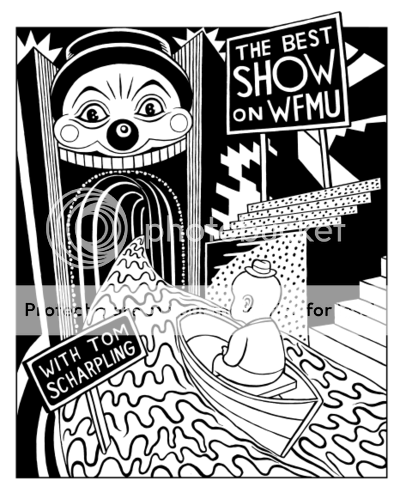
* T-Shirt of the Day, low-end edition: Look, I’m not gonna lie, I’m attracted to this drawing of a post-apocalyptic Velma by Travis Pitts, available as an $18 Threadless t-shirt. Pale knock-kneed girls, you make the rockin’ world go ’round.

* Happy Birthday to Martin Scorsese, the greatest living American director, whose best film is Casino.
* Finally, Mightygodking’s “Scenes from an Alternate Universe Where the Beatles Accepted Lorne Michaels’ Generous Offer” is really magnificent. I’m not going to spoil a thing beyond that, even though I so, so want to, just to attract certain people into reading it. But if any of the words in the title appeal to you on any level, please go read it, and then come back and we’ll talk about it in the comments. (Via Matthew Perpetua.)
Comics Time: Follow Me
November 16, 2009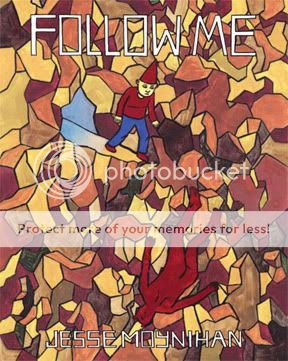
Follow Me (Backwards Folding Mirror #3)
Jesse Moynihan, writer/artist
Bodega, 2009
120 pages
$10
This book’s a tough nut to crack, mostly, I think, because it doesn’t work. There are plenty of familiar altcomix elements present here, from slacker/douchebag observational slice-of-life humor, to gross-out gags and dick jokes and sex comedy, to little fantasy creatures having incongruously realistic and vulgar misadventures, to stream-of-consciousness psychedelic transformations and explorations. All that stuff has been done a million times, and in variations of Moynihan’s knowingly ramshackle black-and-white line to boot–you’ll detect echoes of Matt Furie, Mat Brinkman, Brian Chippendale, Lisa Hanawalt, Alison Cole, Theo Ellsworth, and probably a lot more besides. That said, Follow Me doesn’t feel derivative to me, thanks to Moynihan’s strong, winningly lo-fi character designs and “acting.” His main character, a little dude in a gnome hat, is a pleasure to watch as he’s haplessly buffeted by his own venal impulses and his world’s unpredictable metaphysical freak-outs; he gives Moynihan an opportunity for several standout moments, from his convincingly bewildered look as he gets sucked through a vortex to a goofy little dance he does in which his long shadow effortlessly creates a sense of harsh, bright lighting, a very cool effect.
And yet never does this self-evidently very personal vision burst through the “bubble” of its author’s headspace and communicate its vision of the world to me. I’m sure you don’t need to hear me repeat how much I enjoy comics whose impact is primarily emotional rather than logical, but in such cases I can at least make emotional sense out of what I’m reading due to visual continuity and a tonal through-line, or conversely a tonal juxtaposition,. Here I can do no such thing. Follow Me‘s elements sit awkwardly and uncommunicatively together. I have no idea what the “I can suck my own dick” gags and poop jokes have to do with extended visual riffs on death and multiple planes of existence. And rather than telling an emotional story, the too-frequent, too-abrupt transitions and extended visual extravaganzas just feel like a repeated “and then, and then, and then, and then, and then…” It feels less like daring and more like formlessness. Meanwhile there’s one out-of-nowhere chapter that’s as ill-advised a meditation on race as I’ve seen since David Heatley’s My Brain Is Hanging Upside Down. Much more so than most of the comics that bear the name, this feels like a diary comic, meaning it’s of value primarily to its maker. Which is fine, but caveat lector.
Carnival of souls
November 16, 2009* Today at Robot 6: Follow-up on Marvel’s Hitman Monkey, tracking Al Columbia, and linking the hell out of The Comics Journal #300, currently online in its entirety and as yet completely unread by me.
* Look, it’s Young Hans Rickheit! His photo of himself at age 17 is adorable, and his illustrations from that period are disturbing. That’s our Hans!
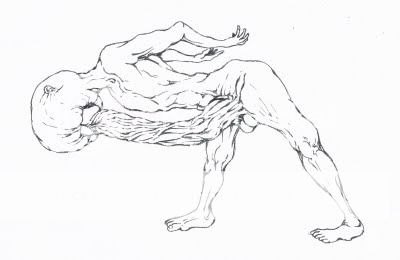
* Wanna rile up comment-thread nerds? Write a list called The 10 Longest and Awesomest Movie Fight Scenes of All Time for Topless Robot but leave off [INSERT YOUR FAVORITE LONG MOVIE FIGHT SCENE HERE], like my buddy TJ Dietsch just did.
* Joe Quesada says Immortal Iron Fist/Immortal Weapons is dunzo. 🙁
* Tom Neely has been posting a series of images called “I just figured it all out…”, all of which are headed for an art show in Stuttgart, Germany. Hie thee to Stuttgart, Germans.

* I like The Killing Joke a lot, which is why I enjoyed David Wynne’s apologia for the book for Trouble with Comics’ Alan Moore Month. Wynne defends the book against its critics (including its writer!) by saying it’s a powerful pacifist powerful. I myself like to look at it as a story about people locked in a relationship that brings out the absolute worst in both of them. It’s also a good fucked-up Joker story. And I’m sure someone could (if someone hasn’t already) draw some parallels between the shaggy-dog joke ending of Moore’s book starring a character called the Comedian and the shaggy-dog joke ending of Moore’s book starring a character called the Joker. Something for everyone! (Bolland’s colors > Higgins’s colors, though.)
* Johnny Ryan’s Gossip Girl. ‘Nuff said!
* I have no doubt that this really is how Dan Nadel spends his weekends.
